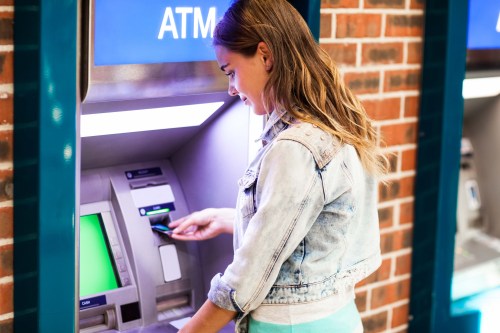Chequing vs. Savings: What’s the Difference?

It’s a nice problem to have: Where is the best place to stash your wads of cash? Chequing account? Savings account? Secret subterranean vault? If you’re not Bruce Wayne, the last option probably isn’t practical—or economical if your money situation is more modest than what we’ve described above.
For teens who are ready to open an account or shift their money from one account to another, it’s helpful to know the difference between the types of accounts available in order to figure out which one best suits their needs. So, chequing versus savings: Here’s how each type of bank account works and how your teen can decide which one is right for them. Spoiler alert: The answer *might* be both!
Key takeaways
- A chequing account is designed for daily use to cover expenses and small purchases. Think: lunch, taxi fare, a movie ticket.
- Thanks to direct deposit, pay from a part-time job can be automatically sent to a chequing account.
- Chequing accounts typically don’t pay interest.
- A savings account is a secure place to keep money you’re stashing away for big future purchases, like a car or a vacation.
- Unlike with a chequing account, money in a savings account might earn interest over time.
- The choice between a chequing account and a savings account will depend on financial needs and goals—the best option might be to have both!
Chequing accounts versus savings accounts
Here’s one way to explain the difference between the two accounts to your teen: If a chequing account and a savings account were physical objects in your house, a chequing account would be like your wallet while a savings account would be like your piggy bank. One gives you easy access to the money you need for regular expenses (pizza, a movie ticket, subway fare), while the other provides a safe place to store your money long-term or to accumulate money to put toward a big purchase (college tuition, a car, a new computer).
What is a chequing account used for?
Your teen can think of a chequing account as the place where all the action happens—money is moving in and out, being deposited and withdrawn, often on a daily basis. That’s because they’ll probably use funds from a chequing account for everyday expenses like school lunches, a comic book, nail polish, gas money, and so on. It can also be used to make online purchases from vendors that accept debit payments through platforms like Interac Online.

If your teen signs up for a chequing account, they’ll receive a debit card to use at ATMs and stores. They may also get a chequebook, which is rarely used these days but was, you can tell them, once a common way to pay for stuff. (Tell them to ask their grandparents about it.)
If they have a part-time job, a chequing account is also very likely the place where their paycheque is deposited if their employer uses direct deposit (instead of handing them an actual paper paycheque every few weeks). To set this up, all they need to do is give their boss a void cheque or supply them with their transit (or branch) number, institution number, and bank account number. Not only is direct deposit paperless and environmentally friendly, it also allows them to get paid faster.
Read more about finding a job as a teenager.
Pros and cons of chequing accounts
The great thing about a chequing account is that the money in it is easy to access and spend. The not-so-great thing about a chequing account is that…the money in it is easy to access and spend. Depending on your teen’s financial goals (say, saving for a car or taking a gap year), a chequing account might not be the best place to put ALL of their money. In bank-speak, these types of accounts are called “transactional,” meaning they’re designed for money to flow into and out of smoothly and simply—through ATMs, at stores, for online purchases, and more. This is a big pro if they want to buy lunch but a con if they keep spending the money they’re trying to save for a new computer on a daily slice of cheese pizza.
Chequing accounts can also have fees attached, and they don’t typically pay interest (or if they do, it’s a teeny tiny amount). Some have limits on how many transactions you can make in a month, and additional fees are charged if you go over that number.
If your teen chooses to have a chequing account, have them check out what kinds of fees are charged and if the account’s features line up with their needs. Banks often offer student accounts with lower fees or even no-fee chequing accounts that could save them serious money. Sigh—yet another perk of student life!
What is a savings account used for?
The number one goal of a savings account is right there in the name: It’s for saving, rather than spending, money. Not only is it a secure place for your teen to store their cash, a savings account might actually EARN them a bit more cash by paying a small amount of interest on the money they keep in the account.
While your teen can access the money in their savings account at any time, withdrawal fees are sometimes attached. But let them know that those fees can help discourage them from moving money out early. That’s right—we just put a positive spin on fees. Insert sunglasses emoji guy here.
Check out our savings calculator for kids to see how long it’ll take your kids and teens to save for those items on their wish list.
Pros and cons of savings accounts
One of the best things about a savings account is the security and predictability it provides. Unlike other types of investment products (think: stocks, bonds, and cryptocurrency), a savings account offers the opportunity to earn money on an investment without the risk factor. Think of it as a zero-stress account.
Having savings also means having a financial safety net when surprise or emergency expenses pop up. Most Canadian banks don’t charge monthly fees for savings accounts, but the downside is that there can be a limit on how often your teen can withdraw their money or a fee attached to withdrawals. This is another way this type of account encourages saving over spending.
Read more about how teens can gamify saving money.
Should teens open a chequing account or a savings account?
If your teen knows what their financial goals are, then it might be easier for them to decide what kind of account they should open. And the answer might actually be: both!

If they’ve just landed their first part-time or summer job, then a chequing account will make it easier for them to receive their pay and cover expenses like getting to and from work or buying a snack during their break. A chequing account will give them the freedom to make their own decisions about the money they earn as well as help them build a solid platform of experience in managing their own money. Your teen will have a record (also known as a bank statement) of how money moves in and how much faster it can move out if they aren’t careful with their spending.
Maybe your teen doesn’t yet have a job or very many expenses that require cash from sources beyond the Bank of Mom and Dad (with those unbeatable interest rates and loan terms). A savings account can act as a secure place to stash that birthday money from the grandparents or occasional babysitting bonuses.
Ideally, they’ll eventually open both types of accounts. If they’re earning money, they can make a plan to put aside a portion of their pay in a savings account. They can even set up their accounts to work together automatically, transferring a portion of their money into savings each month or each pay period. Motivation-wise, it’ll help your teen if they have a goal for the money they save—whether it’s a BIG DEAL goal like tuition or a just-for-fun goal like a vacation.
Tip: Not sure whether to open an account with a credit union or a bank? Read more about the difference between banks and credit unions.
Can you have a savings account without a chequing account?
Absolutely. For younger kids, a savings account is a great entry point into the world of money and finance and a safe place for them to learn about things like how savings can grow thanks to interest.
Can you change a savings account to a chequing account?
Heck yes, you can! While the process of converting a savings account to a chequing account varies between banks, RBC makes it easy to do without even having to visit your local branch. Your teen can just log on to their online banking account and head to the self-service page, where they’ll find the “Change account type” option. They can even keep using the same bank card at the ATM.
Even if your kid has been learning about managing their money since their first visit from the tooth fairy, it can feel like a whole new thing when it comes time to sign up for a savings account and/or a chequing account.
The Mydoh Smart Cash Card is a useful and innovative tool for parents to help coach their kids to develop smart spending and saving strategies before they open their first account. Early practice with practical money skills helps lead to success in your kids’ financial future.
Download Mydoh and help build the foundation of financial literacy for your kids and teenagers.
This article offers general information only and is not intended as legal, financial or other professional advice. A professional advisor should be consulted regarding your specific situation. While the information presented is believed to be factual and current, its accuracy is not guaranteed and it should not be regarded as a complete analysis of the subjects discussed. All expressions of opinion reflect the judgment of the author(s) as of the date of publication and are subject to change. No endorsement of any third parties or their advice, opinions, information, products or services is expressly given or implied by Royal Bank of Canada or its affiliates.














